Students’ Perceived Priorities on Water as a Human Right, Natural Resource, and Multiple Goods
Abstract
1. Introduction
2. Materials and Methods
3. Results
3.1. Global View
3.2. Case Countries: Latvia, South Africa, and Finland
3.2.1. Latvia
3.2.2. South Africa
3.2.3. Finland
3.3. Comparisons of Case Countries
4. Discussion
5. Conclusions
Author Contributions
Funding
Acknowledgments
Conflicts of Interest
References
- UNICEF; WHO. Progress on Drinking Water, Sanitation and Hygiene: 2017 Update and SDG Baselines. 2017. Available online: https://www.unicef.org/publications/index_96611.html (accessed on 17 September 2019).
- McDonald, R.I.; Green, P.; Balkc, D.; Feketeb, B.M.; Revenga, C.; Todd, M.; Montgomery, M. Urban growth, climate change, and freshwater availability. Proc. Nat. Acad. Sci. USA 2011, 108, 6312–6317. [Google Scholar] [CrossRef] [PubMed]
- Correia, F.N. ‘Institutional Water Issues in Europe’. Madrid. IWRA Conference. 2003. Available online: https://iwra.org/member/congress/resource/MADRID2003_FranciscoNunes_Correia_EN.pdf (accessed on 17 September 2019).
- Perry, C.J.; Rock, M.; Seckler, D. Water as an Economic Good: A Solution, or a Problem? Research Report 14; International Irrigation Management Institute: Colombo, Sri Lanka, 1997. [Google Scholar]
- Mashauri, D.A.; Katko, T.S. Water supply development and tariffs in Tanzania: From free water policy towards cost recovery. Environ. Manag. 1993, 17, 31–39. [Google Scholar] [CrossRef]
- Schouten, M.; Schwartz, K. Water as a political good: Implications for investments. International Environmental Agreements. Politics Law Econ. 2006, 6, 407–421. [Google Scholar]
- Ioris, A.A.R. The positioned construction of water values: Pluralism, positionality and praxis. Environ. Values 2012, 21, 143–162. [Google Scholar] [CrossRef]
- Ioris, A.A.R.; Costa, M.A.M. The challenge to revert unsustainable trends: Uneven development and water degradation in the Rio de Janeiro Metropolitan Area. Sustainability 2009, 1, 133–160. [Google Scholar] [CrossRef]
- North, D.C. Institutions, Institutional Change, and Economic Performance; Cambridge University Press: Cambridge, UK, 1990. [Google Scholar]
- Pettinger, T. Washington Consensus—Definition and criticism. Economics. 2017. Available online: http://www.economicshelp.org/blog/7387/economics/washington-consensus-definition-and-criticism/ (accessed on 17 September 2019).
- Semple, A. Privatised water services in England and Wales. In Sound Institutional Strategies for Water Supply and Sanitation Services, Proceedings of the UETP-EEE Short Modular Course, Tampere, Finland, 8–9 December 1993; Hukka, J.J., Juhola, P., Katko, T.S., Morange, H., Eds.; Institute of Water and Environmental Engineering, Tampere University of Technology: Tampere, Finland, 1994; pp. 35–38. [Google Scholar]
- Okun, D. Personal communication 23 September 1992. In Reorganisation of Water Management in England and Wales 1945–1991; Kubo, T., Ed.; Japanese Sewage Works Association: Tokyo, Japan, 1994; pp. 30–37. [Google Scholar]
- Hukka, J.; Katko, T. Water Privatisation Revisited—Panacea or Pancake? IRC Occasional Paper Series No. 33; International Water and Sanitaion Centre: Delft, The Netherlands, 2003; 179p, Available online: http://www.ircwash.org/resources/water-privatisation-revisited-panacea-or-pancake (accessed on 17 September 2019).
- International Conference on Water and the Environment (ICWE). The Dublin Statement and Report of the Conference; World Meteorological Organization: Geneva, Switzerland, 1992; Available online: http://www.wmo.int/pages/prog/hwrp/documents/english/icwedece.html (accessed on 17 September 2019).
- Franceys, R. GATS, ‘Privatization’ and institutional development for urban water provision: Future postponed? Prog. Dev. Stud. 2008, 8, 45–58. [Google Scholar] [CrossRef]
- Annez, P.C. Urban Infrastructure Finance from Private Operators: What Have We Learnt from Recent Experience? World Bank Policy Research Working Paper 4045; The World Bank: Washington, DC, USA, 2006; Available online: web.worldbank.org/archive/website01021/WEB/IMAGES/WPS4045.PDF (accessed on 8 May 2019).
- PPIAF. Public-Private Partnerships for Urban Water Utilities: A Review of Experiences in DCs. 2009. Available online: https://openknowledge.worldbank.org/handle/10986/2703 (accessed on 17 September 2019).
- Bakker, K. Privatizing Water. Governance Failure and the World´s Urban Water Crisis; Cornell University Press: Ithaca, NY, USA, 2010. [Google Scholar]
- Ahlers, R. Fixing and nixing: The politics of water privatization. Rev. Radic. Political Econ. 2010, 42, 213–223. [Google Scholar] [CrossRef]
- Castro, J.E. Neoliberal water and sanitation policies as a failed development strategy: Lessons from developing countries. Prog. Dev. Stud. 2008, 8, 63–83. [Google Scholar] [CrossRef]
- Vinnari, E.M.; Hukka, J.J. Great expectations, tiny benefits—Decision-making in the privatization of Tallinn Water. Util. Policy 2007, 15, 78–85. [Google Scholar] [CrossRef]
- Peda, P.; Vinnari, E. The discursive legitimation of profit in public-private service delivery. Crit. Perspect. Account. 2019. accepted. [Google Scholar] [CrossRef]
- Galiani, S.; Gertler, P.; Schargrodsky, E. Water for life: The impact of the privatization of water services on child mortality. J. Political Econ. 2005, 113, 83–120. [Google Scholar] [CrossRef]
- Clarke, G.R.; Kosec, K.; Wallsten, S. Has private participation in water and sewerage improved coverage? Empirical evidence from Latin America. J. Int. Dev. 2009, 21, 327–361. [Google Scholar] [CrossRef]
- Pigeon, M.; McDonald, D.A.; Hoedeman, O.; Kishimoto, S. (Eds.) Remunicipalisation: Putting Water Back into Public Hands; Transnational Institute: Amsterdam, The Netherlands, 2012. [Google Scholar]
- Water Remunicipalisation Tracker. Berlin. Available online: http://www.remunicipalisation.org/#case_Berlin (accessed on 17 September 2019).
- Lanz, K.; Eitner, K. D12: WaterTime Case Study—Berlin, Germany. 2005. Available online: http://www.watertime.net/wt_cs_cit_ncr.html (accessed on 17 September 2019).
- Wuolle, B. ‘Kuntain Teknilliset Liikeyritykset’. Ensimmäiset Kaupunkipäivät HELSINGISSÄ 16–17.9.1912. Pöytäkirja; Kuntaliiton Arkisto: Helsinki, Finland, 1912; pp. 88–103. [Google Scholar]
- Aiken, W. Human rights in an ecological era. Environ. Values 1992, 1, 191–203. [Google Scholar] [CrossRef]
- UN. Resolution Adopted by the General Assembly 64/292. The Human Right to Water and Sanitation. 2010. Available online: https://www.un.org/waterforlifedecade/human_right_to_water.shtml (accessed on 17 September 2019).
- World Water Assessment Programme (WWAP). Managing Water under Uncertainty and Risk; The United Nations World Water Development Report 4; UNESCO: Paris, France, 2012; Available online: http://www.unwater.org/publications/managing-water-uncertainty-risk/ (accessed on 17 September 2019).
- Harsha, J. Conflicts and dilemma of human right to water. Curr. Sci. 2011, 100, 1778–1780. [Google Scholar]
- Benton, T. Environmental values and human purposes. Environ. Values 2008, 17, 201–220. [Google Scholar] [CrossRef]
- Khadkaa, A. The emergence of water as a ‘human right’ on the world stage: Challenges and opportunities. special issue: Asian perspectives on water policy. Int. J. Water Resour. Dev. 2010, 26, 37–49. [Google Scholar] [CrossRef]
- Hill, T., Jr. Finding value in nature. Environ. Values 2006, 15, 331–341. [Google Scholar] [CrossRef]
- Zenner, C. Valuing fresh waters. Cultural-religious multiplicities. WIREs Water 2019. [Google Scholar] [CrossRef]
- Bakker, K. Commons versus commodities: Debating the human right to water. In The Right to Water: Politics, Governance, and Social Struggles, 1st ed.; Sultana, F., Loftus, A., Eds.; Routledge: London, UK, 2012; pp. 19–44. [Google Scholar]
- Barraque, B. Author response to right of reply by Anne Le Strat, deputy Mayor of Paris, to the article “Return of Drinking water supply in Paris to public Control”. Water Policy 2014, 16, 422–424. [Google Scholar] [CrossRef]
- Langford, M. The United Nations concept of water as a human right: A new paradigm for old problems? Int. J. Water Resour. Dev. 2005, 21, 273–282. [Google Scholar] [CrossRef]
- Yavuz, H. The manavgat project of Turkey: Water, an economic good. Int. J. Water Resour. Dev. 1997, 13, 561–566. [Google Scholar] [CrossRef]
- Pietilä, P.; Katko, T.; Seppälä, O. Uniqueness of Water Services. E–Water. 2010. Available online: http://www.ewa-online.eu/e-water-documents.html (accessed on 17 September 2019).
- Kapp, K. Tips for Creating an Interactive Learning Event. 2013. Available online: http://karlkapp.com/tips-for-creating-an-interactive-learning-event/ (accessed on 17 September 2019).
- Cornes, R.; Sandler, T. The Theory of Externalities, Public Goods, and Club Goods; Cambridge University Press: Cambridge, UK, 1986. [Google Scholar]
- Prevos, P. Customer Experience Management for Water Utilities. Marketing Urban Water Supply; IWA Publishing: London, UK, 2018. [Google Scholar]
- McKenzie, S. Clean Water in South Africa; Human Rights and Constitutional Protections. Global Policy 26 November 2012. Available online: https://blogs.lse.ac.uk/africaatlse/2012/11/26/clean-water-in-south-africa-human-rights-and-constitutional-protections/ (accessed on 17 September 2019).
- Ide, T.; Thiel, A.-K.; Fischhendler, L. The critical geopolitics of water conflicts in school textbooks: The case of Germany. Water Altern. 2019, 12, 304–321. [Google Scholar]
- Rosling, H.; Rosling, O.; Rosling-Rönnlund, A. Factfulness. Ten Reasons We’re Wrong about the World and Why Things Are Better than You Think; Sceptre Books: London, UK, 2018. [Google Scholar]
- Hussein, H. A critique of water scarcity discourses in educational policy and textbooks in Jordan. J. Environ. Educ. 2018, 49, 260–271. [Google Scholar] [CrossRef]
- European Environment Agency (EEA). Freshwater—State and Impacts (Latvia). Available online: http://www.eea.europa.eu/soer/countries/lv/freshwater-state-and-impacts-latvia (accessed on 17 September 2019).
- Chenoweth, J.; Barnett, T.; Capelos, C.; Fife-Schaw, C.; Kelay, T. Comparison of consumer attitudes between Cyprus and Latvia: An evaluation of effect of setting on consumer preferences in the water industry. Water Res. Manag. 2010, 24, 4339–4358. [Google Scholar] [CrossRef]
- Morris, H. How Cape Town Beat the Worst Drought in Its History. The Telegraph, 6 July 2018. Available online: https://www.telegraph.co.uk/travel/destinations/africa/south-africa/cape-town/articles/day-zero-averted-cape-town-drought/ (accessed on 17 September 2019).
- The Water Project. Water in Crisis—South Africa. Available online: https://thewaterproject.org/water-crisis/water-in-crisis-south-africa (accessed on 17 September 2019).
- Mashauri, D.A. (University of Namibia, Windhoek, Namibia). Personal communication, 8 May 2019.
- Weerakoon, S.B. (University of Peradeniya, Peradeniya, Sri Lanka). Personal communication, 8 December 2018.
- Grigg, N.S. (Colorado State University, Fort Collins, CO, USA). Personal communication, 29 November 2018.
- Katko, T.; Rajala, R. Priorities for fresh water use purposes in selected countries with policy implications. Int. J. Water Resour. Dev. 2005, 21, 311–323. [Google Scholar] [CrossRef]
- International Law Association. The Berlin Rules on Water Resources. 20. ‘Vital Human Needs’. 2004. Available online: http://www.cawater-info.net/library/eng/l/berlin_rules.pdf (accessed on 17 September 2019).
- Grigg, N.S. Water as a connector among societal needs. In Grigg, Integrated Water Resources Management. An Interdisciplinary Approach; Grigg, N.S., Ed.; Palgrave/Macmillan: London, UK, 2016; pp. 1–18. [Google Scholar]
- Kishimoto, S.; Lobina, E.; Petitjean, O. Our Public Water Future. The Global Experience with Remunicipalisation; Transnational Institute (TNI): Amsterdam, The Netherlands; Public Services International Research Unit (PSIRU): London, UK; Multinationals Observatory: Paris, France; Municipal Services Project (MSP): Cape Town, South Africa; European Federation of Public Service Unions (EPSU): Brussels, Belgium, 2015; Available online: http://www.psiru.org/sites/default/files/2015-04-W-OurPublicWaterFutureFINAL.pdf (accessed on 17 September 2019).
- Plimmer, G.; Pickard, J. Gove Attacks Water Industry over High Pay and Dividends; Financial Times: London, UK, 2018. [Google Scholar]
- Biswas, A.K. Why Water Deserves More Respect. MEGA. 2016. Available online: https://mega.online/en/articles/why-water-deserves-more-respect (accessed on 17 September 2019).
- Melosi, M.V. Precious Commodity. Providing Water for America’s Cities; Pittsburgh Press: Pittsburgh, PA, USA; University of Pittsburgh: Pittsburgh, PA, USA, 2011. [Google Scholar]
- Han, S.; Koo, D.D.; Kim, Y.; Kim, S.; Park, J. Gap analysis based decision support methodology to improve level of service of water services. Sustainability 2017, 9, 1578. [Google Scholar] [CrossRef]
- Compagnucci, L.; Spigarelli, F. Fostering cross-sector collaboration to promote innovation in the water sector. Sustainability 2018, 10, 4154. [Google Scholar] [CrossRef]
- Habib, E.; Deshotel, M. Towards broader adoption of educational innovations in undergraduate water resources engineering: Views from academia and industry universities council on water resources. J. Contemp. Water Res. Educ. 2018, 164, 41–54. [Google Scholar] [CrossRef]
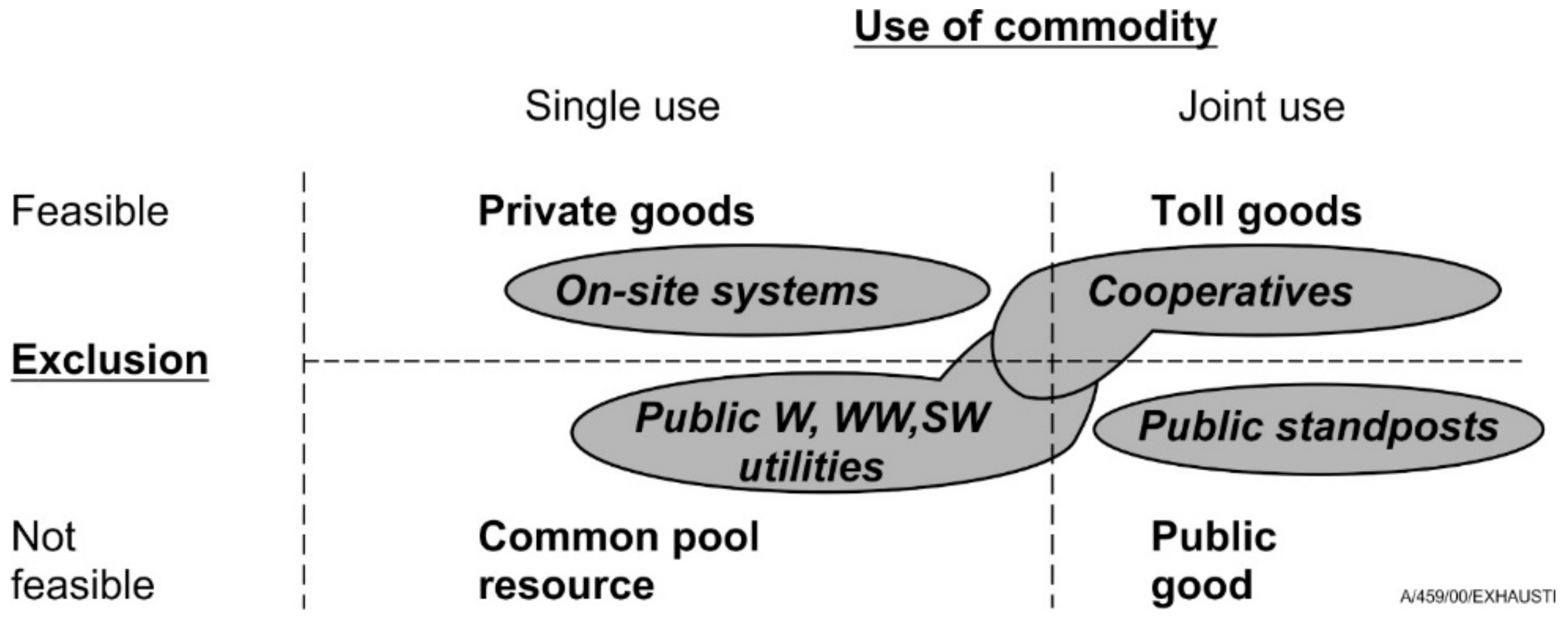
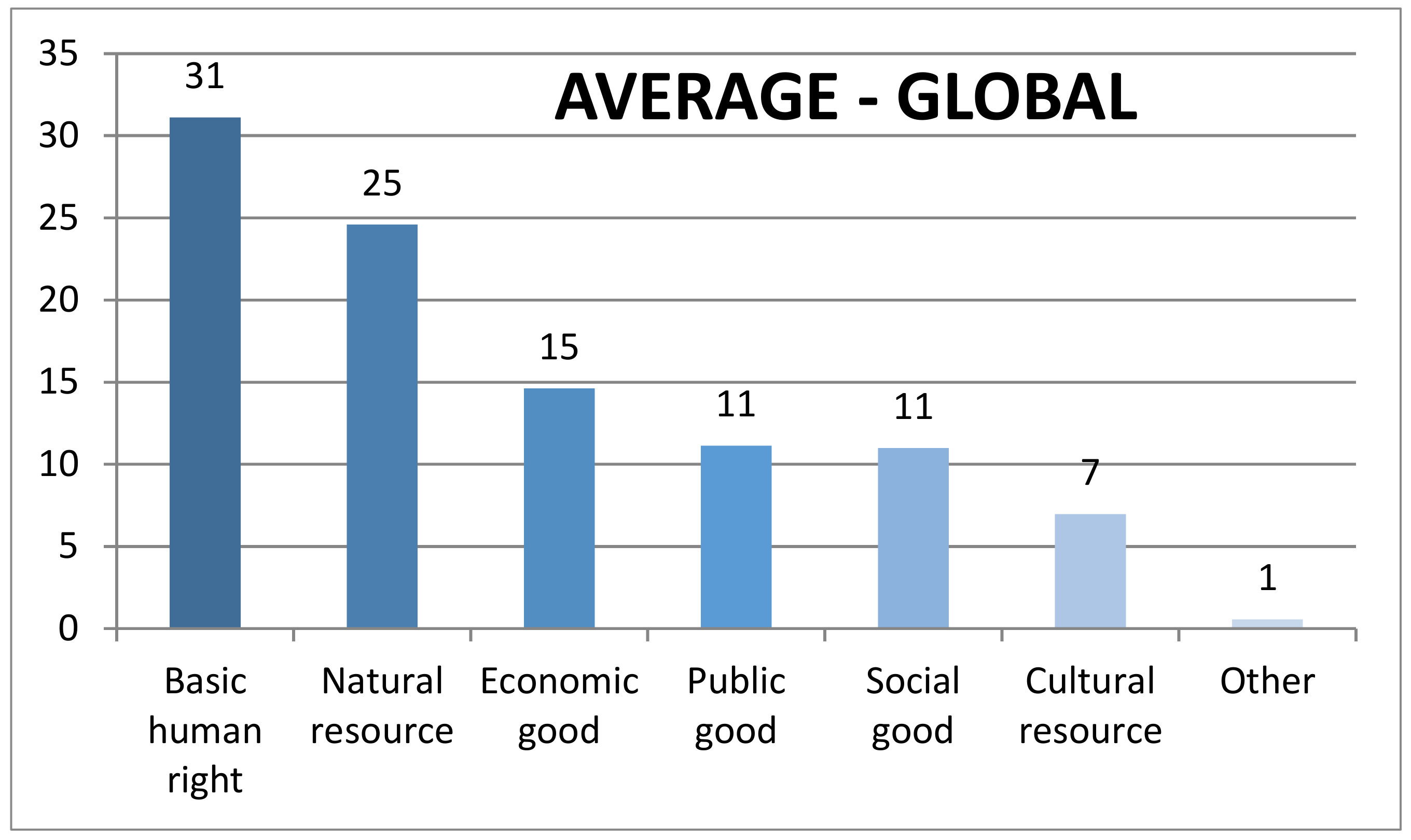
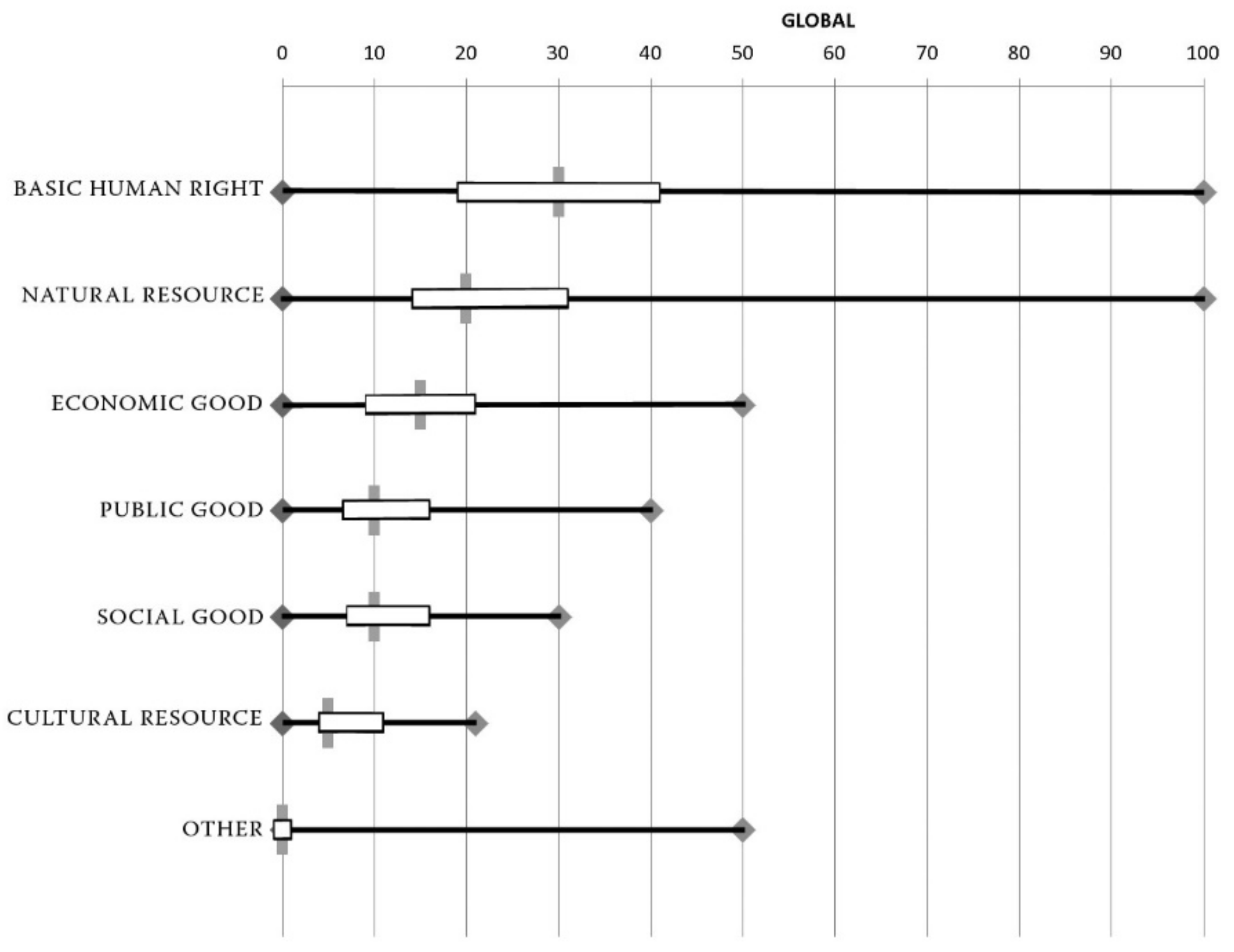
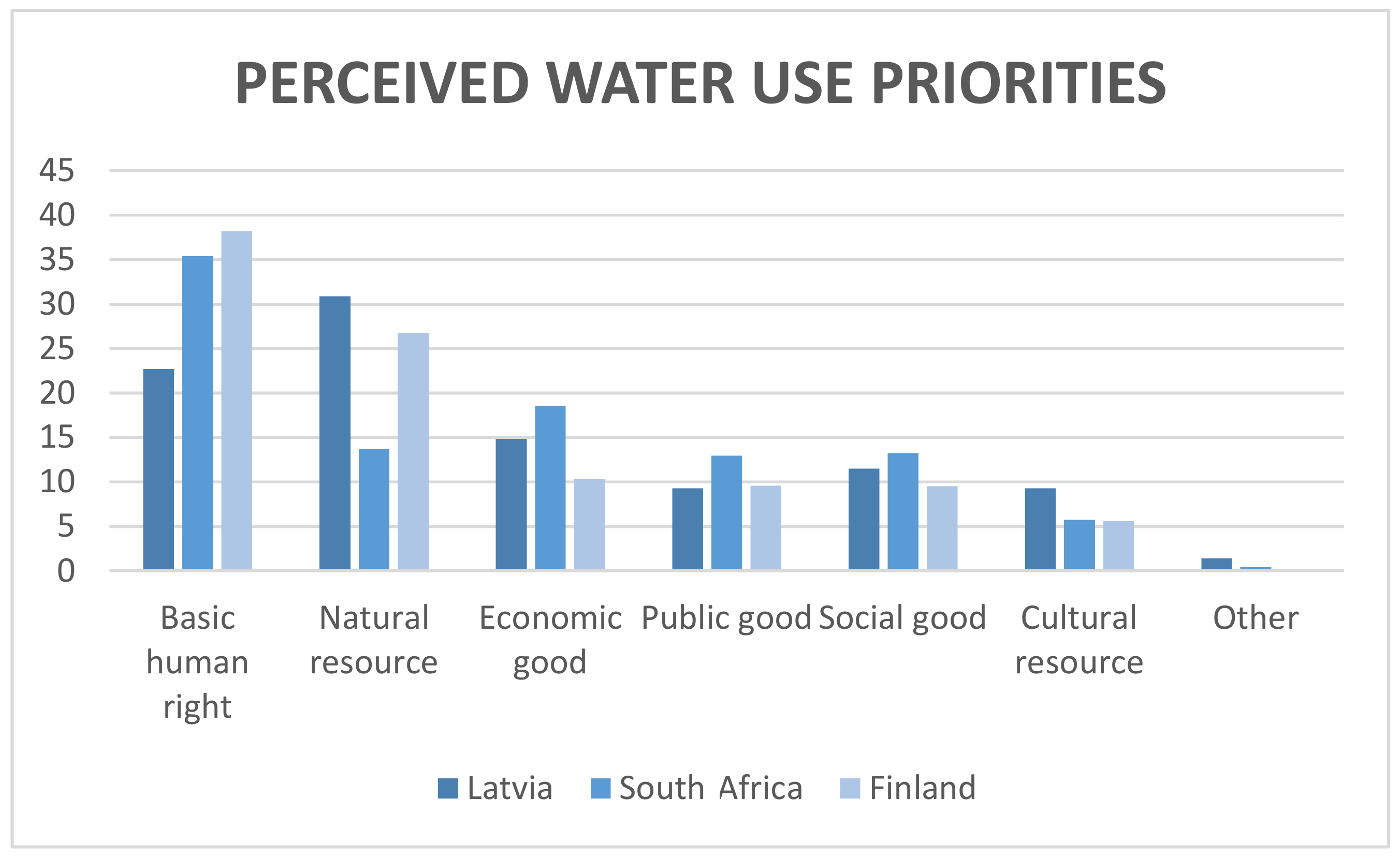
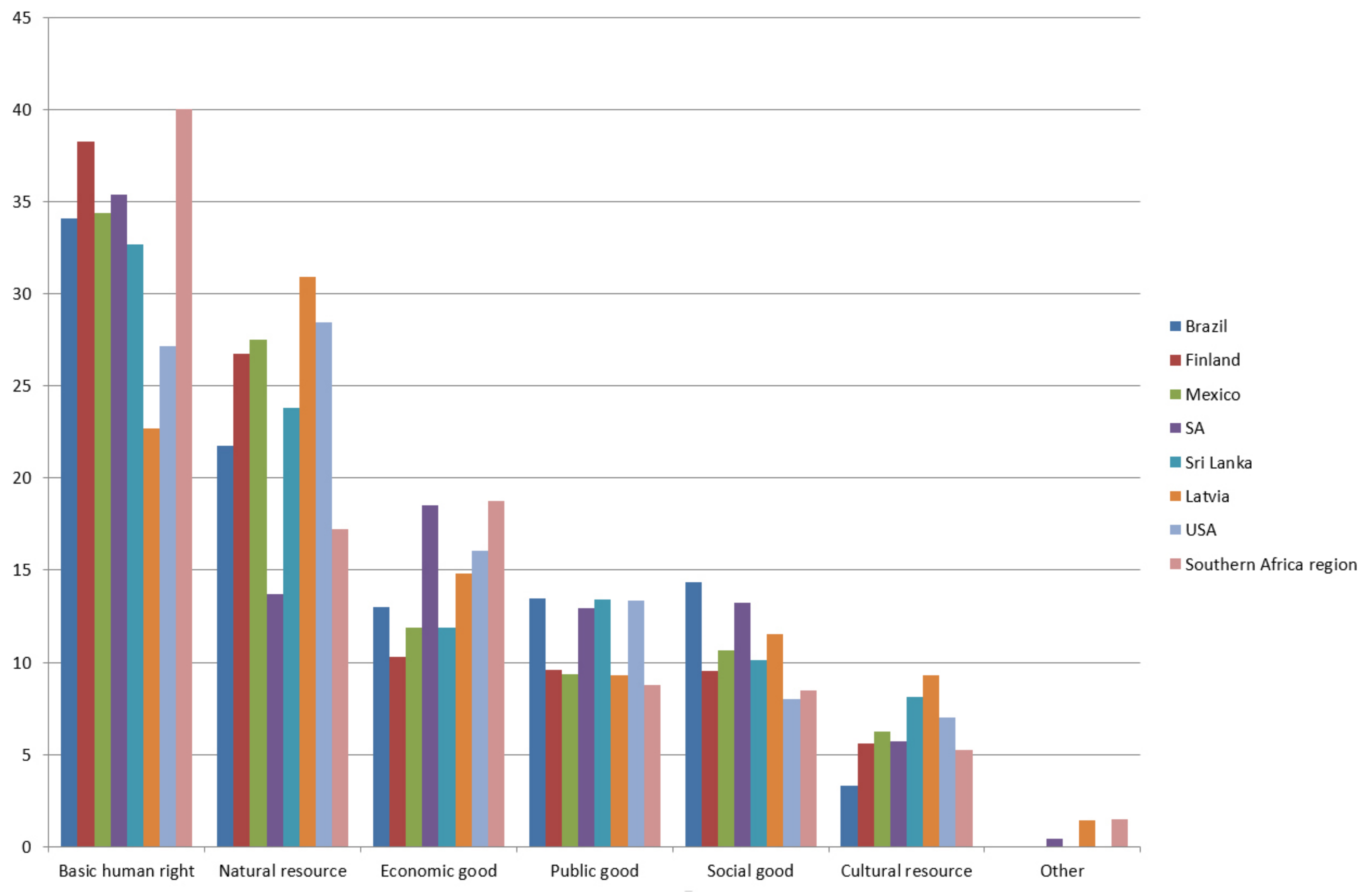
| Country/Region | Respondents | Persons Per Group | Degree Aimed at |
|---|---|---|---|
| Brazil | 17 | 2 × 8, 1 × 1 | BSc in Env. Eng. |
| Finland | 31 | 3 × 1, 2 × 12, 1 × 4 | BSc and MSc. in Env. Eng. |
| Mexico | 9 | 2 × 1, 1 × 7 | BSc and MSc. related to water |
| South Africa | 46 | 3 × 2, 2 × 20 | BSc and MSc. in Civil & Env. Eng. |
| Sri Lanka | 31 | 3 × 1, 2 × 14 | BSc in Civil Engineering |
| Latvia | 71 | 2 × 35, 1 × 1 | BSc and MSc. in Env. Science |
| United States | 24 | 2 × 10, 1 × 4 | BSc and MSc. in Civil & Env. Eng. |
| Southern Africa region | 8 | 1 × 8 | MSc. in Water Resources Eng. |
| 237 |
| Criteria | Views from Latvia |
|---|---|
| Basic human right (23%) | Water as a basis for life and living (20) Equality (13) Means for survival (8) |
| Natural resource (31%) | Life on Earth (26) Basis for all other water-connected aspects (9) Main constituent of Earth, water cycle, important for planet existence (7) Limited resource and unequal access (5) Latvia is rich with waters (2) |
| Economic good (15%) | Water as a basis for economic development and human benefits (26) Development of Latvian economy is strongly based on water resources (3) Economical value allows to prevent excessive water consumption (3) Water must be free for everyone (3) Water as ecosystem service (2) |
| Public good (9%) | Equality and human right (20) The role of clean water (6) The role in recreation (6) Water is not a good, it is invaluable, use without taxes, not private property (4) Water as privilege (4) Availability in Latvia (2) |
| Social good (12%) | Importance for human health (quality of drinking water, recreation) (19) Regional and property differences (not important in Latvia) (9) Not a basic need (4) Water protection and environmental safety (2) Increasing role due to increasing population (2) |
| Cultural good (9%) | Cultural and religious aspects are less important than basic human needs (12) Cultural heritage with emphasis to Latvia (10) Esthetical, recreational value of water landscape (9) Historical role in religion, moral values and symbol (7) Source of inspiration for artists (5) The role in rise of civilization (2) |
| Criteria | Views from South Africa (SA) |
|---|---|
| Basic human right (35%) | Cannot live without water, necessity, essential for survival (17) Needed for basic purposes; should be accessible to everyone, regardless of their financial standing, to avoid inequality; everyone has the right to survive and have proper hygiene (5) High unemployment rate in SA; therefore, many people cannot afford water payments (1) |
| Cultural good (6%) | In favour: Respect of cultures and traditions (5) Not much water is required and varies from community to community (2) Culture for the future generations (1); water for cultural practices can be from the same water supply for public, social, and basic human right (1); people of all cultures require water, but some use water more than others (1) Less in favour: There is no link between culture and water; not a necessity and can be used minimally (3) Urbanization reduces the number of people who need water for cultural reasons (1); all people are not religious and need water for baptism (1); culture has some importance, but can be seen as a want, not a need (1) |
| Economic good (19%) | Needed for agriculture, industrial, mining, construction, etc. (8) People need water, regardless of their economic situation; this ensures quality for social, public, and human right (5) Infrastructure for providing water, maintenance (2) |
| Natural resource (14%) | SA has vast natural resources, unique environment aquatic life and ecosystems that need to be sustained and protected (6) Water as a natural attraction, other than esthetic appeal, can promote tourism, which can lead to job creation (5) To preserve all natural resources, e.g., birds, animals, trees for future generations, and keeping the natural habitat alive (4) SA is a dry country, therefore water is needed for the environment, needed to support the environment → economy (3) Important for the environment but not a priority; very little of the natural water is visually pleasing and therefore should not take priority (2) |
| Public good (13%) | It is important to have water available and for the general public to have access, to prevent environmental degradation and improve public image (10) Necessary to improve quality of life; people can have a better quality of life and wellness is enhanced, needed for high standard of living (3) Community taps are important in providing water where household water pipes are not available; taps are needed in parks and malls, and supplying the need of the community, e.g., in university (2) Because the public pays tax, the public should have a fair amount of water (2) |
| Social good (13%) | SA has a lot of poor, sick, and vulnerable people that need help (11) People need access to water in households, community centers, and social homes (2) |
| Criteria | Views from Finland |
|---|---|
| Basic human right (38%) | Water is essential, everyone needs it, without water humans will not survive, basic for life (11) Everyone has to have access to water, equality (2) Everyone should have right to water, not related to their economics (1) Health reasons (1) |
| Natural resource (27%) | We are not alone in this world; health, biodiversity, humans are part of nature (4) Water resources should be safe to use (3) Not infinite, a limited natural resource (2) Protecting resources; subject to pollution (2) Part of sustainable development (1) |
| Economic good (10%) | Important for business, industry, agriculture, industry, hydropower (4) Creates jobs (2) Income to the state (2) Economical profit should not be important; water should not be considered as an economic good (3) Water treatment (1) Price of water should not be the most important meter, enough to guarantee good/reliable service (openness, transparency) (1) To be able to keep the systems operational (1) |
| Public good (10%) | All equal with water; everyone should have equal access (2) Everyone needs for living (1) Any area to cover its water needs (1) Water maybe distributed better by non-profit organizations (2) Also, in Finland, water is a common public good, but it is probably not possible worldwide (1) |
| Social good (10%) | Everyone should have equal access to water resources; jobs (3) In Finland, water is a common social good, but probably not possible worldwide (1); not private (1) Requires collaboration—no-one left aside (1) Water is needed in leisure too (1) Everyone needs it for living (1) Conflicts, refreshing (1) |
| Cultural good (6%) | Historical perspective—cultures and societies grow around waterways, close to water. Finnish landscape and history include a lot of water; for Finns, water, especially lakes, hold a cultural value (2) Important part of the nature (2) High importance is recognized; importance for mental health (2) In Finland, everyone is used to having water and accessing it freely (1) Cultural aspects are not so important than other aspects (2) |
© 2019 by the authors. Licensee MDPI, Basel, Switzerland. This article is an open access article distributed under the terms and conditions of the Creative Commons Attribution (CC BY) license (http://creativecommons.org/licenses/by/4.0/).
Share and Cite
Rajala, R.P.; Katko, T.S.; Springe, G. Students’ Perceived Priorities on Water as a Human Right, Natural Resource, and Multiple Goods. Sustainability 2019, 11, 6354. https://doi.org/10.3390/su11226354
Rajala RP, Katko TS, Springe G. Students’ Perceived Priorities on Water as a Human Right, Natural Resource, and Multiple Goods. Sustainability. 2019; 11(22):6354. https://doi.org/10.3390/su11226354
Chicago/Turabian StyleRajala, Riikka P., Tapio S. Katko, and Gunta Springe. 2019. "Students’ Perceived Priorities on Water as a Human Right, Natural Resource, and Multiple Goods" Sustainability 11, no. 22: 6354. https://doi.org/10.3390/su11226354
APA StyleRajala, R. P., Katko, T. S., & Springe, G. (2019). Students’ Perceived Priorities on Water as a Human Right, Natural Resource, and Multiple Goods. Sustainability, 11(22), 6354. https://doi.org/10.3390/su11226354





